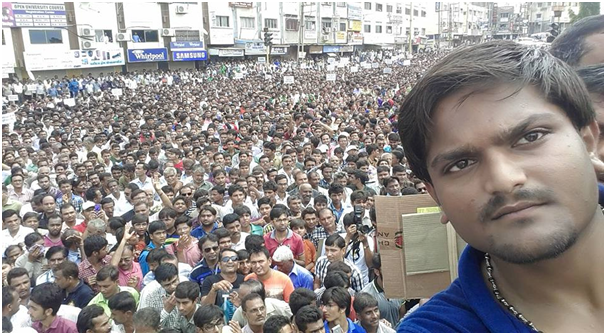Polarised Gujarat Splits into Communities,Youth Anger Feeds Into Hardik Patel's Success
Jobless Patel youth flock behind Hardik Patel. {Photograph taken from his Facebook Page)

NEW DELHI: The inability of the youth to connect with the much touted Gujarat development model peddled by Prime Minister Narendra Modi has resulted in the disillusionment among the socially, economically and politically well off Patel community that now stands at loggerheads with the BJP in Gujarat.
“While the Sangh Parivar or BJP was able to politicize the community in the state, it never defined the concept of development. The youth among the community that voted for BJP and Modi in 2012 state assembly elections and 2014 parliamentary elections stands disillusioned when it comes to government jobs and education. Hardik Patel who leads the agitation is representative of this generation,” said eminent sociologist Gaurang Jani.
Jani said that there has been no major development on the ground in the state under the Modi regime. The state missed the information technology bus and no major large scale industry has come up in the state. The diamond industry that is dominated by Patels in terms of ownership and employment has been in a bad and sad state for several years as well.
Jani pointed out that Patels have no problems in being encapsulated in the Other Backward Castes (OBC) category as it is not stigmatized in Gujarat unlike the Scheduled Castes (SC) and Scheduled Tribes (ST). “The Patels in urban areas are insensitive to the perils of caste system that prevails in the society. The youth just talks of education and jobs.”
Amidst all this, PM Modi clearly stands on the back foot. The very insistence of Patels to be counted as backward and get a share of government jobs, is being seen as the biggest expose of his decade-long propaganda about Gujarat being the role model of development. The media-blitz and the industrial investment in propaganda festivals such as the ‘Vibrant Gujarat Investment Summit’ (its names kept on changing each time) have failed to provide employment opportunities. Even the Patels, the most affluent class among Gujaratis, are now agitated for government quotas in jobs. The privatization of education, which again is led by the Patels, has clearly not helped either.
Local Gujaratis have started questioning the propaganda. A senior journalist in the state spoke for many when he said, “ If there is so much concern amongst the affluent upper castes for government jobs, then the entire exercise of holding Vibrant Gujarat summits for drawing private sector investments and the exercise in setting up Special Economic Zones (SEZs) or Special Investment Regions (SIRs) appear to be a sham.”
The attack coming from Patels who have been PM Modi’s biggest supporters, is a major cause of concern for the entire Sangh Parivar. “If Modi’s policies were questioned by intellectuals, minorities and civil society, that was called criticism. But Patels doing the same can easily be called a certificate of failure,” said an observer.
This agitation that shows no signs of dying down with the determined 22 year old Hardik Patel now in Delhi to meet Patels from other states, is expected to have a significant political impact on Gujarat. PM Modi had consolidated the majority vote after the 2002 violence against the Muslims. The Hindu Hriday Samrat had secured victory in the state polls thrice on basis of this consolidated Hindu vote bank.
This anti-minority image was constantly bolstered as PM Modi, then the Chief Minister, used the slogan of Vibrant Gujarat to become the Vikas Purush. With this agitation the Patels are seen to have broken this majoritarian consensus and fractured the Hindu vote by pushing out other communities like the Thakurs. The BJP concerns rest in the fact that the Patels remain the most powerful – socially, politically and economically – community in the state that is asserting itself against the ruling party in both the centre and the state. And working to what will be a return to the pre 1990 position where the caste consideration prevailed over religious polarisation, that will thus cut directly into the support base engineered by the BJP on the back of the 2002 violence.



